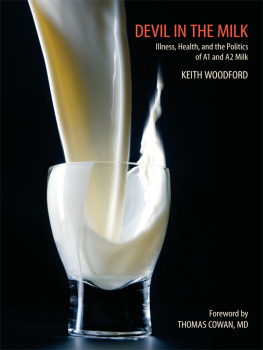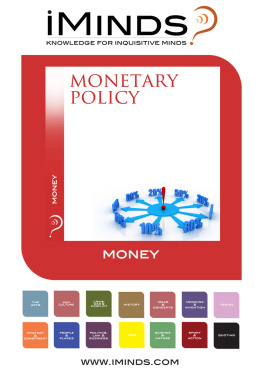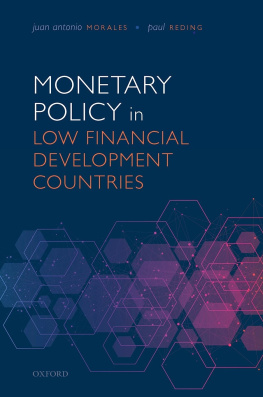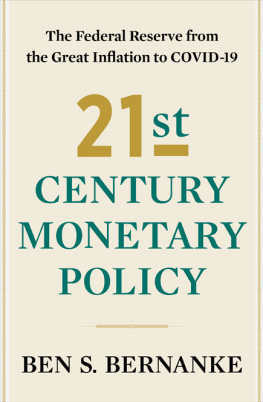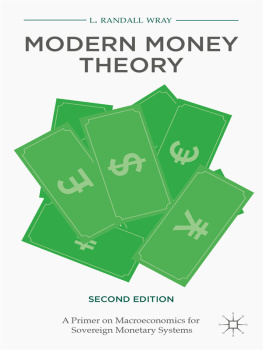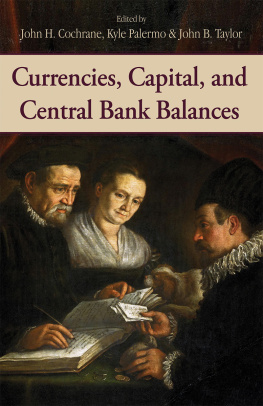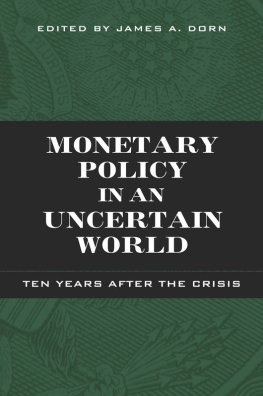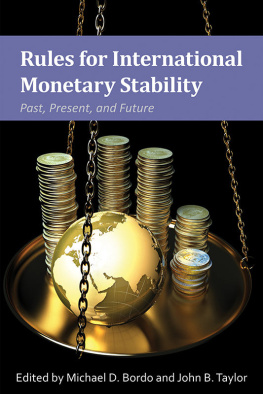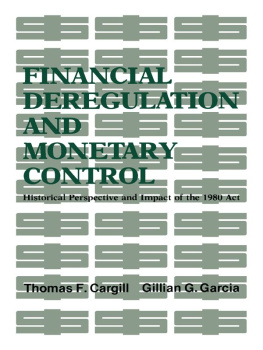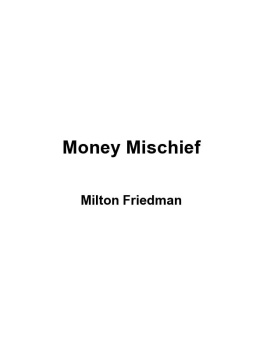Interest and Prices
Interest and Prices
Foundations of a Theory of Monetary Policy
MICHAEL WOODFORD

Copyright 2003 by Princeton University Press
Published by Princeton University Press, 41 William Street,
Princeton, New Jersey 08540
In the United Kingdom: Princeton University Press, 3 Market Place,
Woodstock, Oxfordshire OX20 1SY
All Rights Reserved
ISBN 0-691-01049-8
Library of Congress Control Number 2003106560
British Library Cataloging-in-Publication Data is available
This book has been composed in New Baskerville and Officina Serif
by Princeton Editorial Associates, Inc., Scottsdale, Arizona
Printed on acid-free paper 
www.pupress.princeton.edu
Printed in the United States of America
10 9 8 7 6 5 4 3 2 1
For Argia
CONTENTS
PART I
Analytical Framework
PART II
Optimal Policy
PREFACE
This book is a progress report on my struggles with two problems that have engaged me since graduate school. The first is the problem of reconciling macroeconomics with microeconomic theory without simply ignoring the main concerns of the tradition of macroeconomic thought that stretches back long before Keynesabove all, the question of how to understand and mitigate the temporary departures from an efficient utilization of existing productive capacity that result from slow adjustment of wages or prices. My advisor, Bob Solow, always insisted on the unity of microeconomics and macroeconomics, and wore both hats with equal flair. He challenged me, while I was still writing my dissertation, to try to integrate sticky prices into the kind of intertemporal general-equilibrium models that were then becoming the dominant paradigm for macroeconomic analysis. Another of my teachers, Peter Diamond, insisted upon the importance of a public economics that would allow an integrated treatment of inefficient allocation of resources across sectors and macroeconomic stabilization. It has taken me twenty years to come up with a response to these challenges that I am not embarrassed to submit. I hope that tardiness will not be judged sufficient grounds in itself for a failing grade.
The second is the problem of reconciling central bankers understanding of what they do with the way that monetary policy is conceived in theoretical monetary economics. It has long been the understanding of bankers that the crucial monetary policy question is that of the appropriate level for short-term nominal interest rates. Yet the theoretical literature has, until recently, always modeled monetary policy in terms of a central banks control of the supply of base money or the implications of its actions for the evolution of some broader monetary aggregate. In the literature that I studied in school, interest rates were not only not central to the way in which candidate policies for analysis were described; much of the time, theoretical frameworks were used in which interest rates were not even determined or (if an interest rate was defined) in which the nominal interest rate would necessarily be zero at all times, regardless of the monetary policy chosen. The Wicksellian tradition of monetary analysis, which I first learned about from Axel Leijonhufvud, has been an important source of inspiration for my efforts to show that one can indeed conceive of monetary policy in terms of rules for the adjustment of an operating target for an overnight interest rate, while at the same time insisting upon clear foundations for monetary analysis within the broader framework of intertemporal general equilibrium theory.
The idea of attempting a systematic exposition of this material first originated when I was asked to give a one-week course in macroeconomic theory as part of the Netherlands Network of Economics (NAKE) summer school in Wageningen, in June 1998. I repeated a version of the same lecture series in August of that year at the Federal Reserve Bank of Kansas City and presented a somewhat longer version as a three-week course for doctoral students at the London School of Economics in February 1999. After this, I felt that I had a fairly clear view of what I wanted to say, and began work on this book. Completing the task has taken somewhat longer than I had expected when starting out, partly because research in the area has developed so rapidly since then. Probably the drafts of this manuscript that have circulated since the spring of 1999 have helped to accelerate this, but I have at times wondered if the present moment is really as ripe for a systematic exposition of theory of monetary policy as I had imagined. The present volume is surely not the last word on the subject, but it may perhaps help others to join the conversation.
Most of the research described here has been joint work with a series of co-authors, namely Julio Rotemberg, Ben Bernanke, Lars Svensson, Marc Giannoni, and Pierpaolo Benigno (in roughly chronological sequence). Many of the ideas in this work have really been theirs, though I must take responsibility for any inadequacy of the formulation offered here. I hope that they will forgive me for not mentioning them more frequently in the pages that follow. The general program of research discussed here has also been greatly advanced by the work of a number of my students. In addition to those listed above as co-authors, these include Robert Kollman, Chris Erceg, Stephanie Schmitt-Groh, Martin Uribe, Peter Ireland, Tim Fuerst, Tack Yun, Thomas Laubach, Eduardo Loyo, Rochelle Edge, Kosuke Aoki, Jon Steinsson, Gauti Eggertsson, Bruce Preston, and Hong Li. I would not have gotten as far in my own understanding of these topics without their help.
Given the subject addressed, it should be no surprise that many of my most valuable interlocutors have been in central banks. My research agenda has been particularly shaped by the two years that I served as a consultant to the Federal Reserve Bank of New York, in 19951997, and by the period I was able to spend as a Professorial Fellow at the Reserve Bank of New Zealand in the summer of 2000. I have also benefited greatly from shorter visits to the Federal Reserve Board, the Bank of Canada, the Bank of England, the European Central Bank, the Bank of Sweden, the Bank of Italy, the Bank of Japan, and the Hong Kong Monetary Authority while preparing this study. I am especially grateful to David Archer, Andy Brookes, Kevin Clinton, Chuck Freedman, Spence Hilton, Chris Ryan, and William Whitesell for their patient efforts to educate me about the implementation of monetary policy at their respective central banks.
I owe a considerable debt to Ed Nelson and Argia Sbordone for carefully reading much of this manuscript (and sometimes multiple drafts). I also thank Pierpaolo Benigno, Pelin Berkmen, Olivier Blanchard, Jean Boivin, Michael Dotsey, Peter Dougherty, Gauti Eggertsson, Pedro Garcia Duarte, Tim Fuerst, Jeff Fuhrer, Marvin Goodfriend, Bob Hall, Michael Kiley, Jinill Kim, Hong Li, Eduardo Loyo, Bennett McCallum, Rick Mishkin, Athanasios Orphanides, David Romer, Julio Rotemberg, Juha Seppala, Jon Steinsson, Brad Strum, Lars Svensson, and Marco Vega for comments on various parts of the manuscript, and Gauti Eggertsson, Marc Giannoni, Hong Li, Eduardo Loyo, and Brad Strum for their assistance with the research reported here. Among my Harvard students, Yves Nosbuch deserves special mention for finding the largest number of typos.
I am grateful to the National Science Foundation for supporting the research described here, through a series of grants to the National Bureau of Economic Research, and to the John Simon Guggenheim Memorial Foundation and the Center for Economic Policy Studies, Princeton University, for their support of the sabbatical year during which I was able to plan and begin work on this book. Finally, I thank Peter Dougherty for his continuing enthusiasm for a project that must at some points have seemed unlikely to reach a conclusion.
Next page

